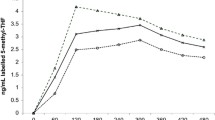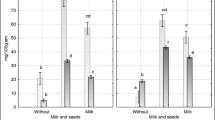Abstract
Background
Bread is an important folate source in several countries. However, bread-making was reported to cause losses of endogenous bread folates (~40%) as well as added synthetic folic acid (~30%). Furthermore, the bread matrix is suggested to inhibit absorption of folates.
Purpose
To (1) estimate retention of both, endogenous folates and synthetic fortificants, during bread-making, (2) assess in vitro folate bioaccessibility from breads and a breakfast meal and (3) assess in vitro folate uptake.
Methods
Retention of folate forms was assessed by preparing fortified (folic acid and [6S]-5-CH3-H4folate) wholemeal breads and collect samples from dough, proofed dough and the bread. In vitro folate bioaccessibility was assessed using the TNO gastrointestinal model TIM. In vitro folate uptake was assessed using a novel Caco-2 cell/stable isotope model. Folate content in samples was measured using LCMS.
Results
Bread-making resulted in losses of 41% for endogenous folates and up to 25 and 65% for folic acid and [6S]-5-CH3-H4folate fortificant, respectively. 75% of endogenous bread folates and 94% of breakfast folates were bioaccessible as assessed by TIM. From [6S]-5-CH3-H4folate-fortified bread, relative folate uptake into Caco-2 cells was 71 ± 11% (P < 0.05) when compared with a standard solution.
Conclusion
Retention of folic acid fortificant during bread-making was substantially higher compared to retention of [6S]-5-CH3-H4folate fortificant. Data from the TIM and Caco-2 cell trials suggest an inhibiting effect of the tested bread matrices on in vitro bioaccessibility of folates, whereas folate bioaccessibility from a breakfast meal is almost complete.


Similar content being viewed by others
References
Czeizel A, Dudas I (1992) Prevention of the first occurrence of neural-tube defects by periconceptional vitamin supplementation. N Engl J Med 327:1832–1835
Dhonukshe-Rutten RAM, de Vries JHM, de Bree A, van der Put N, van Staveren WA, de Groot L (2009) Dietary intake and status of folate and vitamin B12 and their association with homocysteine and cardiovascular disease in European populations. Eur J Clin Nutr 63:18–30
Smith AD, Kim Y-I, Refsum H (2008) Is folic acid good for everyone? Am J Clin Nutr 87:517–533
Becker W, Pearson M (2003) Riksmaten 1997–98, Kostvanor och näringsintag i Sverige (Riksmaten 1997–98. Dietary habits and nutrient intake in Sweden). National Food Administration. Uppsala
Gujska E, Majewska K (2005) Effect of baking process on added folic acid and endogenous folates stability in wheat and rye breads. Plant Foods Hum Nutr 60:37–42
Kariluoto S, Vahteristo L, Salovaara H, Katina K, Liukkonen KH, Piironen V (2004) Effect of baking method and fermentation on folate content of rye and wheat breads. Cereal Chem 81:134–139
Pfeiffer CM, Rogers LM, Bailey LB, Gregory IJF (1997) Absorption of folate from fortified cereal-grain products and of supplemental folate consumed with or without food determined using a dual-label stable-isotope protocol. Am J Clin Nutr 66:1388–1397
Colman N, Green R, Metz J (1975) Prevention of folate deficiency by food fortification. II. Absorption of folic acid from fortified staple foods. Am J Clin Nutr 28:459–464
Finglas PM, Witthöft CM, Vahteristo L, Wright AJA, Southon S, Mellon FA, Ridge B, Maunder P (2002) Use of an oral/intravenous dual-label stable-isotope protocol to determine folic acid bioavailability from fortified cereal grain foods in women. J Nutr 132:936–939
Verwei M, Freidig AP, Havenaar R, Groten JP (2006) Predicted serum folate concentrations based on in vitro studies and kinetic modeling are consistent with measured folate concentrations in humans. J Nutr 136:3074–3078
Verwei M (2004) Bioaccessibility of folate from several liquid and solid food products. Thesis. Wageningen University. Wageningen
Öhrvik V, Witthöft C (2008) Orange juice is a good folate source in respect to folate content and stability during storage and simulated digestion. Eur J Nutr 47:92–98
Arkbåge K, Verwei M, Havenaar R, Witthöft C (2003) Bioaccessibility of folic acid and (6S)-5-methyltetrahydrofolate decreases after the addition of folate-binding protein to yogurt as studied in a dynamic in vitro gastrointestinal model. J Nutr 133:3678–3683
Verwei M, van den Berg H, Havenaar R, Groten JP (2005) Effect of folate-binding protein on intestinal transport of folic acid and 5-methyltetrahydrofolate across Caco-2 cells. Eur J Nutr 44:242–249
Enghardt-Barbieri H, Lindwall C (2005) Swedish Nutrition Recommendations Objectified (SNO)—basis for general advice on food consumption for healthy adults. National Food Administration, Uppsala
Pfeiffer CM, Rogers LM, Gregory JF (1997) Determination of folate in cereal-grain food products using trienzyme extraction and combined affinity and reversed-phase liquid chromatography. J Agric Food Chem 45:407–413
Jastrebova J, Witthöft C, Grahn A, Svensson U, Jägerstad M (2003) HPLC determination of folates in raw and processed beetroots. Food Chem 80:579–588
Konings EJM (1999) A validated liquid chromatographic method for determining folates in vegetables, milk powder, liver and flour. J AOAC Int 82:119–125
Nygren L, Sternesjö A, Björck L (2003) Determination of folate-binding proteins from milk by optical biosensor analysis. Int Dairy J 13:283–290
Ashokkumar B, Mohammed ZM, Vaziri ND, Said HM (2007) Effect of folate oversupplementation on folate uptake by human intestinal and renal epithelial cells. Am J Clin Nutr 86:159–166
Mason JB, Shoda R, Haskell M, Selhub J, Rosenberg IH (1990) Carrier affinity as a mechanism for the pH-dependence of folate transport in the small-intestine. Biochim Biophys Acta 1024:331–335
Lemos C, Peters G, Jansen G, Martel F, Calhau C (2007) Modulation of folate uptake in cultured human colon adenocarcinoma Caco-2 cells by dietary compounds. Eur J Nutr 46:329–336
Salovaara S, Larsson Alminger M, Eklund-Jonsson C, Andlid T, Sandberg A-S (2003) Prolonged transit time through the stomach and small intestine improves iron dialyzability and uptake in vitro. J Agric Food Chem 51:5131–5136
Tallkvist J, Tjalve H (1998) Transport of nickel across monolayers of human intestinal Caco-2 cells. Toxicol Appl Pharmacol 151:117–122
Patring JDM, Jastrebova JA (2007) Application of liquid chromatography-electrospray ionisation mass spectrometry for determination of dietary folates: Effects of buffer nature and mobile phase composition on sensitivity and selectivity. J Chromatogr A 1143:72–82
Konings EJM, Roomans HHS, Dorant E, Goldbohm RA, Saris WHM, van den Brandt PA (2001) Folate intake of the Dutch population according to newly established liquid chromatography data for foods. Am J Clin Nutr 73:765–776
Vahteristo L, Lehikoinen K, Ollilainen V, Varo P (1997) Application of an HPLC assay for the determination of folate derivatives in some vegetables, fruits and berries consumed in Finland. Food Chem 59:589–597
Dietrich M, Brown CJP, Block G (2005) The effect of folate fortification of cereal-grain products on blood folate status, dietary folate intake, and dietary folate sources among adult non-supplement users in the United States. J Am Coll Nutr 24:266–274
van Oort FVA, Melse-Boonstra A, Brouwer IA, Clarke R, West CE, Katan MB, Verhoef P (2003) Folic acid and reduction of plasma homocysteine concentrations in older adults: a dose–response study. Am J Clin Nutr 77:1318–1323
Öhrvik VE, Olsson JC, Sundberg BE, Witthöft CM (2009) Effect of 2 pieces of nutritional advice on folate status in Swedish women: a randomized controlled trial. Am J Clin Nutr 89:1053–1058
Acknowledgments
We thank R. Havenaar and M. Verwei at TNO for carrying out TIM experiments and K. Damstedt and I. Börjesson (Cerealia R&D, Järna, Sweden) for bread-making. A. Kamal-Eldin and M. Jägerstad are acknowledged for valuable comments on the manuscript. We thank P. Artursson at Uppsala University for donation of Caco-2 cells, L. Babul at SLU for folate-binding protein and H. Nygaard Lærke at University of Aarhus for porcine bile. Non-labelled folate standards were kind gifts from Merck Eprova AG, Schaffhausen, Switzerland. This study was supported by the Swedish Research Council Formas and the Cerealia Foundation R&D.
Conflict of interest statement
The authors declare that they have no conflict of interest.
Author information
Authors and Affiliations
Corresponding author
Rights and permissions
About this article
Cite this article
Öhrvik, V., Öhrvik, H., Tallkvist, J. et al. Folates in bread: retention during bread-making and in vitro bioaccessibility. Eur J Nutr 49, 365–372 (2010). https://doi.org/10.1007/s00394-010-0094-y
Received:
Accepted:
Published:
Issue Date:
DOI: https://doi.org/10.1007/s00394-010-0094-y




